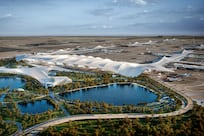The small peninsula of Qatar has dominated the narrow world of gas like a colossus. Since the global financial crisis, its control of a third of the global liquefied natural gas business (LNG) has allowed it to influence prices, ride out market shocks and profit immensely. But now Doha faces new challenges, to which its strategy offers no easy solution.
Qatar, which spent the millennium’s first decade building up the world’s largest LNG export business, could have been buffeted by two shocks – the disappearance of the US market because of its shale boom, and the Great Recession. But its dominance in LNG is far more than the oil industry in Saudi Arabia, which holds just 10 per cent of the market.
It was able to shift supplies to Asia to countries such as Japan and South Korea, which are entirely dependent on LNG for gas, while sending surplus volumes to Europe at lower prices to compete with Russia. The 2011 accident at Fukushima caused Japan to shut down its nuclear power plants, further boosting LNG demand and driving prices to US$20 per million British thermal units, compared to just $3 to $4 in the United States.
But now the LNG market is shifting. Asian LNG prices fell to below $11 in July, their lowest point since before Fukushima, and UK gas was below $7. They should pick up again when winter returns, and the market seems oddly relaxed over the threat to Russian gas supplies through Ukraine, which could lead Europe to scramble for LNG later this year.
But as Japan gradually restarts its nuclear reactors, the supply-demand balance also looks to be easing. New buyers are pushing to break the traditional linkage of LNG prices to oil, and to base them on US and European markers instead.
Qatar’s LNG exports will continue to be enormously lucrative, with the lowest production costs in the world and enormous volumes of valuable by-product petroleum liquids. But if it is not going to expand capacity further, it does not have the strategic ability to deter competitors. And there is a lot of new competition coming up.
Against Qatar’s 77 million tonnes of LNG capacity, Australia will have 85 million tonnes by late this decade, and by the mid-2020s the US may have built 50 million tonnes or more, and Canada another 35 million to 50 million tonnes. Mozambique’s and Tanzania’s giant gas finds will be delayed from the very ambitious schedules advertised, but they too should arrive in the 2020s, while Russia seeks to compete more in China and the East Asian market.
How can Qatar respond? In 2005, it decided to impose a moratorium on further expansion of the North Field, the source of nearly all its gas. The country could add another 12 million tonnes per year of capacity by debottlenecking its existing plants, and the North Field has ample reserves, but Qatar seems in no hurry to launch new projects. Meanwhile, exploration for deeper reservoirs beneath the North Field has so far not enjoyed commercial success. Current gas projects concentrate on supplying domestic power and petrochemicals.
In partnership with its favoured ally, ExxonMobil, Qatar Petroleum is planning to build an LNG export plant at Sabine Pass in Texas. This gives its portfolio greater depth and diversity, but with nothing like the profitability of its domestic investments.
Lower prices would be a boon for the environment, in displacing cheap coal. Gas – often too highly priced – would be able to expand its forecast “golden age” beyond North America. That is good news for residents and consumers in smoky Asian cities. But for Qatar, it means diminished geopolitical weight and an intensified imperative to find new drivers of economic growth as it becomes apparent that the gas colossus has feet of clay.
Robin Mills is the head of consulting at Manaar Energy and the author of The Myth of the Oil Crisis
Follow The National's Business section on Twitter




